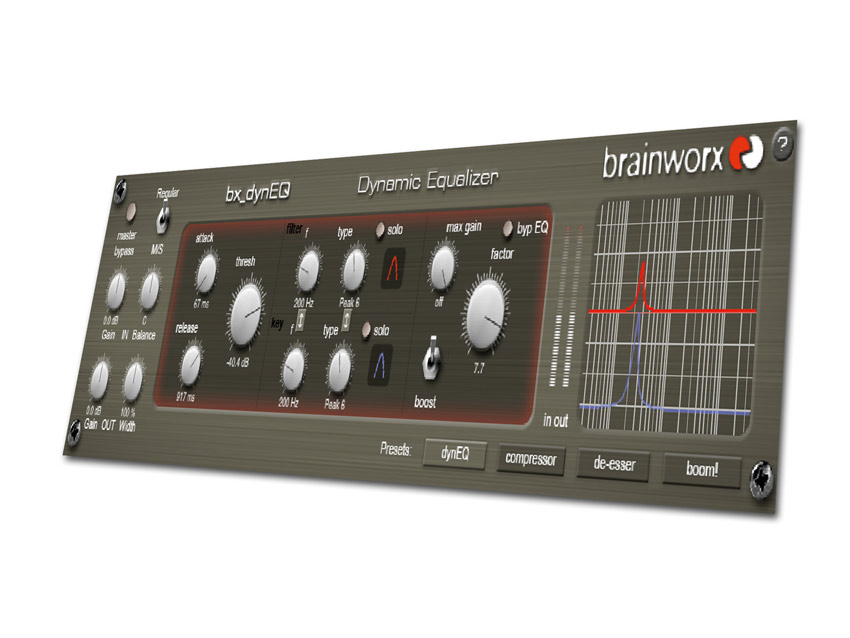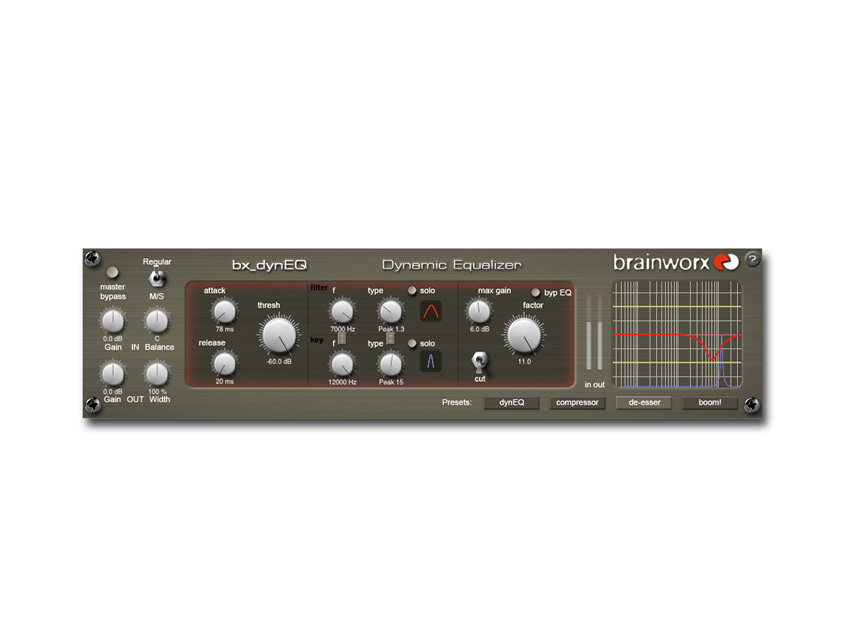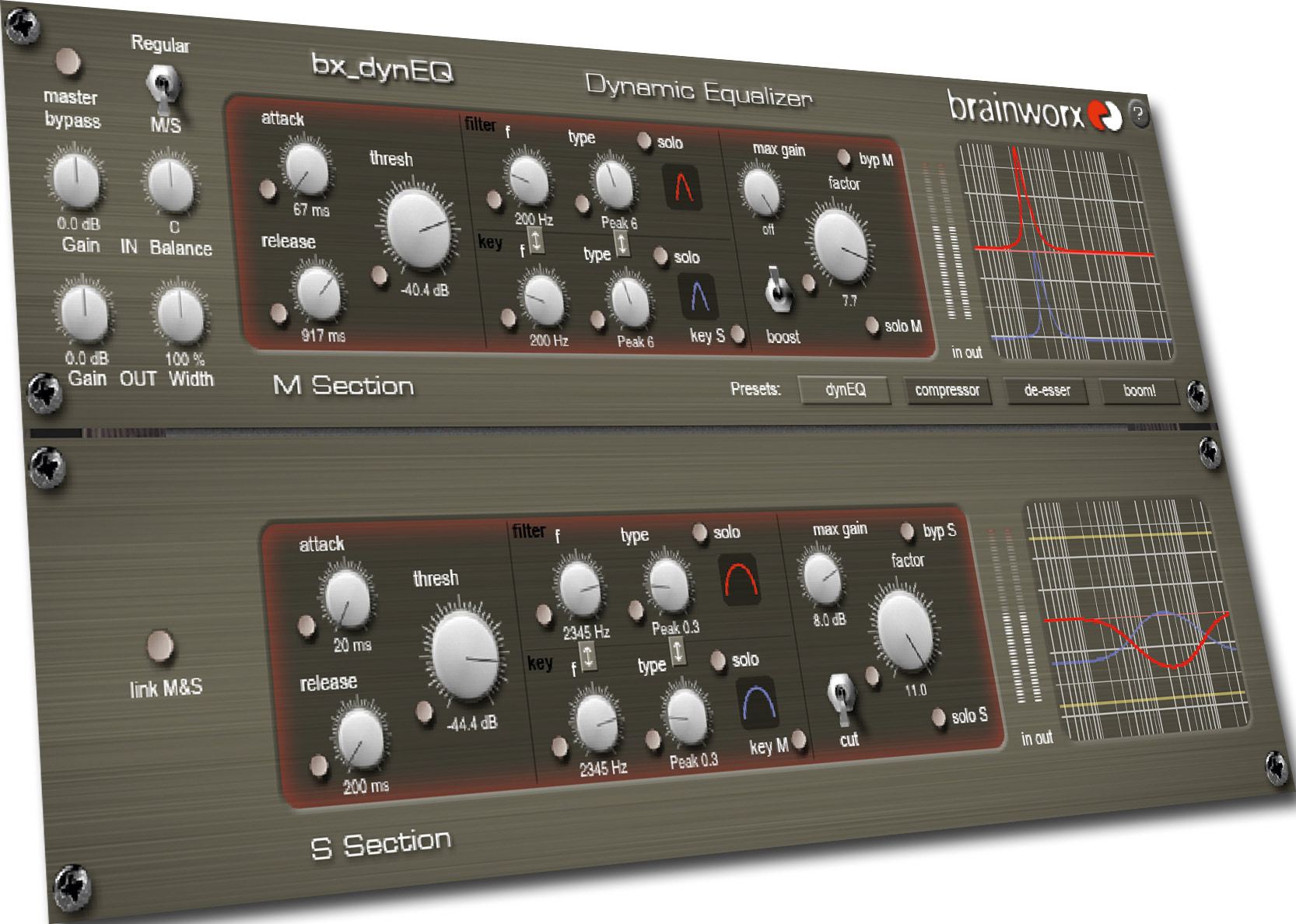MusicRadar Verdict
BX Dynamic EQ is a focused but excellent plug-in with the added benefit of M/S processing.
Pros
- +
Multitude of filter shapes. Some excellent monitoring options. M/S control.
Cons
- -
Can be hard-going.
MusicRadar's got your back

BrainWorx Dynamic EQ Plug-ins

BrainWorx Dynamic EQ Plug-ins

BrainWorx Dynamic EQ Plug-ins
The Dynamic EQ bundle comprises two effects: Boom! and BX Dynamic EQ.
Both plug-ins are dynamic EQs but come in very different forms. BX Dynamic EQ is the fully-featured design with a multitude of parameters and 'starting-point' presets for dynamic EQ, de-essing, compressing and kick drum processing.
Boom! on the other hand is a cutdown, two parameter version of its sibling aimed solely at boosting or cutting kick drum punch. In keeping with the M/S (Mid/Side) concepts it's already developed, it shouldn't surprise you to hear that BX Dynamic EQ also incorporates an M/S mode.
In detail
So what differentiates the BX Dynamic EQ from its simpler sibling? On the face of it, loads of controls, but if you keep in mind the basic concepts of dynamic EQ (think of a de-esser), then the interface is less daunting.
The central panel is divided into three sections dealing with dynamics, filter type and effect level. The dynamics section - threshold, attack and release - deals with the point at which processing starts and how that occurs (the attack and release).
The Level section to the right lets you choose either cut or boost and select a maximum processing limit (0dB to 12dB). There's also a factor parameter, which you can think of as a bit like a compressor ratio (values range from 1 to 11).
So these are the basic settings, but the real action goes on in the Filter section. First up, you'll notice it has two sections (Filter and Key) providing independent control over trigger frequencies (Key) and the frequencies they act on (Filter).
Want all the hottest music and gear news, reviews, deals, features and more, direct to your inbox? Sign up here.
Beyond this, there's also control over filter type (24 in total) including peak, band-pass, low- and high-pass filters and shelving.
In many situations you'll want Key and Filter settings to be the same, and you can link frequency, type or both to achieve this quickly. Even so, the option to select them individually is enormously flexible.
So far, so good - but there's yet another layer to BX Dynamic EQ concerning M/S processing. Among the master settings to the left you can choose between stereo and M/S mode.
In stereo mode you get one set of controls to process left and right signals equally. However, switch over to M/S mode and the plug-in doubles in size, providing individual controls for the mid and sides.
Finally, you'll note that whichever mode you use, there's also an overall Width control (mono to 400%) indicating the underlying M/S roots of the plug-in.
BX Dynamic EQ includes four 'starting point' presets (dynEQ, compressor, de-esser and boom!). For example, the de-esser setting has a high key frequency (12kHz) with a sharp peak, but applies a softer peak at a lower frequency (7kHz) to the signal. The level control is set to cut with a factor of 11, but with max gain of 6dB.
If this all seems a bit confusing, the graphic display to the right puts it into context. Here the key filter is blue, the limits are yellow and the actual reduction is shown dynamically in red.
In use
So how do you go about using a processor like this? Obviously, you need the right candidate (a sibilant or harsh vocal say) that needs momentary EQ change. But most importantly you need to be able to monitor your key and effected signal.
With individual solo options for key and filter, BX Dynamic EQ works excellently in this respect. Soloing the key enables you to sweep through frequencies, finding your spot easily. But it's the filter solo that's most enlightening as you can hear just the effected part of the signal.
So, tweaking the parameters (threshold, attack, release, gain and factor) you hear what you're doing before switching back and hearing the full effected signal.
Finally, there's also the matter of the M/S processing. This adds another layer of complexity, but once you get used to the M/S concept, it's quite straightforward.
We processed a stereo drum kit room mic, dynamically boosting the body of the snare in mono and dynamically cutting its higher 'crack' frequencies in the stereo aspect. This produced a much more solid blend from a regular stereo room blend.
Turning briefly to the Boom! plug-in, with only three fixed frequencies (32, 48 and 64Hz) there's not much room for manoeuvre. Even so, it gives instant results on kick drums, and it's nice to be able to cut very low frequencies.
Summary
BX Dynamic EQ is a serious and complex plug-in, and Boom! seems to have been included as a bit of light relief. Even so, if you understand why you need this sort of plug-in, then you won't be confused by how it works.
Once again, BrainWorx has delivered an individual but brilliantly thought out plug-in that provides powerful processing in a deceptively simple manner.
Hear the BX Dynamic EQ in action:
Future Music is the number one magazine for today's producers. Packed with technique and technology we'll help you make great new music. All-access artist interviews, in-depth gear reviews, essential production tutorials and much more. Every marvellous monthly edition features reliable reviews of the latest and greatest hardware and software technology and techniques, unparalleled advice, in-depth interviews, sensational free samples and so much more to improve the experience and outcome of your music-making.
